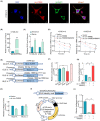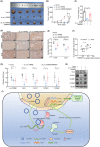Circular RNA circ-FIRRE interacts with HNRNPC to promote esophageal squamous cell carcinoma progression by stabilizing GLI2 mRNA
- PMID: 37417427
- PMCID: PMC10475760
- DOI: 10.1111/cas.15899
Circular RNA circ-FIRRE interacts with HNRNPC to promote esophageal squamous cell carcinoma progression by stabilizing GLI2 mRNA
Abstract
Increasing evidence has shown that circular RNAs (circRNAs) interact with RNA-binding proteins (RBPs) and promote cancer progression. However, the function and mechanism of the circRNA/RBP complex in esophageal squamous cell carcinoma (ESCC) are still largely unknown. Herein, we first characterized a novel oncogenic circRNA, circ-FIRRE, by RNA sequencing (Ribo-free) profiling of ESCC samples. Furthermore, we observed marked circ-FIRRE overexpression in ESCC patients with high TNM stage and poor overall survival. Mechanistic studies indicated that circ-FIRRE, as a platform, interacts with the heterogeneous nuclear ribonucleoprotein C (HNRNPC) protein to stabilize GLI2 mRNA by directly binding to its 3'-UTR in the cytoplasm, thereby resulting in elevated GLI2 protein expression and subsequent transcription of its target genes MYC, CCNE1, and CCNE2, ultimately contributing to ESCC progression. Moreover, HNRNPC overexpression in circ-FIRRE knockdown cells notably abolished circ-FIRRE knockdown-mediated Hedgehog pathway inhibition and ESCC progression impairment in vitro and in vivo. Clinical specimen results showed that circ-FIRRE and HNRNPC expression was positively correlated with GLI2 expression, which reveals the clear significance of the circ-FIRRE/HNRNPC-GLI2 axis in ESCC. In summary, our results indicate that circ-FIRRE could serve as a valuable biomarker and potential therapeutic target for ESCC and highlight a novel mechanism of the circ-FIRRE/HNRNPC complex in ESCC progression regulation.
Keywords: GLI2; HNRNPC; circRNA; esophageal squamous cell carcinoma; hedgehog signaling.
© 2023 The Authors. Cancer Science published by John Wiley & Sons Australia, Ltd on behalf of Japanese Cancer Association.
Conflict of interest statement
The authors have no conflicts of interest.
Figures






Similar articles
-
EIF4A3-mediated oncogenic circRNA hsa_circ_0001165 advances esophageal squamous cell carcinoma progression through the miR-381-3p/TNS3 pathway.Cell Biol Toxicol. 2024 Oct 9;40(1):84. doi: 10.1007/s10565-024-09927-9. Cell Biol Toxicol. 2024. PMID: 39382613 Free PMC article.
-
Circular RNA hsa_circ_0000654 promotes esophageal squamous cell carcinoma progression by regulating the miR-149-5p/IL-6/STAT3 pathway.IUBMB Life. 2020 Mar;72(3):426-439. doi: 10.1002/iub.2202. Epub 2019 Nov 28. IUBMB Life. 2020. PMID: 31778020
-
Hsa_circ_0006948 enhances cancer progression and epithelial-mesenchymal transition through the miR-490-3p/HMGA2 axis in esophageal squamous cell carcinoma.Aging (Albany NY). 2019 Dec 26;11(24):11937-11954. doi: 10.18632/aging.102519. Epub 2019 Dec 26. Aging (Albany NY). 2019. PMID: 31881015 Free PMC article.
-
Current advances and future perspectives on the functional roles and clinical implications of circular RNAs in esophageal squamous cell carcinoma: more influential than expected.Biomark Res. 2022 Jun 7;10(1):41. doi: 10.1186/s40364-022-00388-y. Biomark Res. 2022. PMID: 35672804 Free PMC article. Review.
-
Roles of circRNA dysregulation in esophageal squamous cell carcinoma tumor microenvironment.Front Oncol. 2023 Jun 13;13:1153207. doi: 10.3389/fonc.2023.1153207. eCollection 2023. Front Oncol. 2023. PMID: 37384299 Free PMC article. Review.
Cited by
-
Circular RNAs and Cancers.Adv Exp Med Biol. 2025;1485:273-327. doi: 10.1007/978-981-96-9428-0_18. Adv Exp Med Biol. 2025. PMID: 40886283 Review.
-
The role of N(6)-methyladenosine (m6a) modification in cancer: recent advances and future directions.EXCLI J. 2025 Jan 15;24:113-150. doi: 10.17179/excli2024-7935. eCollection 2025. EXCLI J. 2025. PMID: 39967906 Free PMC article. Review.
-
Regulatory mechanisms of m6A RNA methylation in esophageal cancer: a comprehensive review.Front Genet. 2025 Apr 22;16:1561799. doi: 10.3389/fgene.2025.1561799. eCollection 2025. Front Genet. 2025. PMID: 40330012 Free PMC article. Review.
-
Circular RNA circNCOA3 promotes tumor progression and anti-PD-1 resistance in colorectal cancer.Cancer Drug Resist. 2024 Mar 13;7:9. doi: 10.20517/cdr.2023.151. eCollection 2024. Cancer Drug Resist. 2024. PMID: 38510750 Free PMC article.
-
HNRNPC as a pan-cancer biomarker and therapeutic target involved in tumor progression and immune regulation.Oncol Res. 2024 Dec 20;33(1):83-102. doi: 10.32604/or.2024.055866. eCollection 2025. Oncol Res. 2024. PMID: 39735682 Free PMC article.
References
-
- Bray F, Ferlay J, Soerjomataram I, Siegel RL, Torre LA, Jemal A. Global cancer statistics 2018: GLOBOCAN estimates of incidence and mortality worldwide for 36 cancers in 185 countries. CA Cancer J Clin. 2018;68:394‐424. - PubMed
-
- Ohashi S, Miyamoto S, Kikuchi O, Goto T, Amanuma Y, Muto M. Recent advances from basic and clinical studies of esophageal squamous cell carcinoma. Gastroenterology. 2015;149:1700‐1715. - PubMed
-
- Kristensen LS, Andersen MS, Stagsted LVW, Ebbesen KK, Hansen TB, Kjems J. The biogenesis, biology and characterization of circular RNAs. Nat Rev Genet. 2019;20:675‐691. - PubMed
MeSH terms
Substances
Grants and funding
LinkOut - more resources
Full Text Sources
Medical

